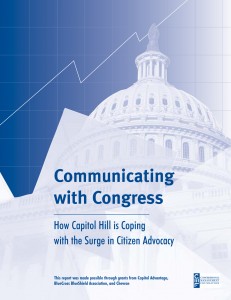 In 2005, CMF surveyed and interviewed more than 300 House and Senate staffers on their opinions and practices related to constituent communications. This report explores the surge in communications to congressional offices, how offices are reacting to the increased workload and how they view constituent communications practices. Whether you are a congressional staffer or a citizen or grassroots organization, this report is an essential read.
In 2005, CMF surveyed and interviewed more than 300 House and Senate staffers on their opinions and practices related to constituent communications. This report explores the surge in communications to congressional offices, how offices are reacting to the increased workload and how they view constituent communications practices. Whether you are a congressional staffer or a citizen or grassroots organization, this report is an essential read.
![]() Communicating with Congress: How Capitol Hill is Coping with the Surge in Citizen Advocacy (754 KB)
Communicating with Congress: How Capitol Hill is Coping with the Surge in Citizen Advocacy (754 KB)
Key findings:
- Congress received four times more communications in 2004 than 1995—all of the increase from Internet-based communications. Congress received 200,388,993 communications in 2004: the House received 10,400,000 communications by post and 99,053,399 via the Internet; the Senate received 7,935,594 by post and 83,000,000 via the Internet. During this decade, the staffing levels of Members’ personal offices have not changed.
- Congressional offices are devoting more resources to managing the growing volume of constituent communications. Of managers surveyed, 73% say their offices spend more time on constituent communications than two years ago. Half of House and Senate senior managers surveyed also report their offices have reallocated resources to responding to communications over the last two years. However, only 17% of House offices and 38% of Senate offices answer all incoming e-mail with e-mail. The large majority of offices respond to some or all of their e-mail with postal letters.
- The Internet is generally having a positive effect on the discourse between citizens and Congress. A large majority of congressional staff surveyed, 79%, believe the Internet has made it easier for citizens to become involved in public policy; 55% believe it has increased public understanding of what goes on in Washington; and a plurality of 48% believe it has made Members more responsive to their constituents.
- Many congressional staff doubt the legitimacy of identical form communications, and want to know whether communications are sent with constituents’ knowledge and consent. Half of congressional staff surveyed believe identical form communications are not sent with constituents’ knowledge or consent. Another 25% are unsure about the legitimacy of these communications. Additionally, 89% would like the ability to differentiate list-generated campaigns from those sent through direct constituent action.
- Personalized or individualized messages to Congress have more influence on Members’ decision-making process than do identical form messages. Only 3% of staff surveyed say identical form postal mail would have “a lot” of influence on their Member of Congress if he/she had not reached a decision. In contrast, 44% report individualized postal letters would have “a lot” of influence.
- People who engage in political activities online or who write to their elected officials are very likely to be active members of their communities. Citizens who write or call their elected officials are about six times more likely than the general public to belong to a group trying to influence public policy or to attend a political rally, speech or protest; three times more likely to write an article for a magazine or newspaper; and four times more likely to work for a political party. Consequently, constituents who write Congress tend to be politically active and have disproportionate political influence in their communities.


